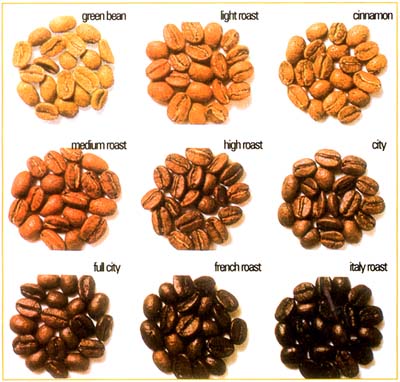How roasted coffee bean affects your
coffee? We know that roasted coffee
bean affects the way our coffee would be, but we have no idea what all
those roasting terminology meant. So, in this article I would attempt to bring
across this message in the simplest way possible.It is sad to note that in today
coffee market, most of the ratings are placed on coffee brewers and lesser on home coffee
roaster, which I personally thought is an element to brewing
great coffee.But, I guess with technology like Illy ability to seal their
roasted coffee flavor for up to 2 years, not knowing how to roast might not
posed too much a problem!
The rule of thumb about roasted coffee bean is the longer it is being roasted, the thicker would be the roast flavor and if not handle properly, it can ruin the beans original flavor and the beans would be useless.
Therefore, coffee beans that are well known for its unique taste like Jamaican Blue Mountain, Hawaiian Kona or the Kenya coffee are roast very lightly so that their original characteristics would dominate the flavor.

1. Light roast
This is the first stage for any roasted coffee bean
and the beans are taken out a few minutes after the beans "pop" or crack" and have expanded in size. The market calls this the first crack and it is by far the most popular roasting method with the US commercial roaster. Also known as cinnamon roast, half city or New England, it is very dry and the coffee it brewed is lighter bodied, very acidic and with almost no roast flavor.
2. Medium Roast
For coffee beans to reach this medium roast, one would have to wait a couple more minutes after the first "crack" and while this is not the in higher quantity, it is what US specialty coffee sellers tend to roast and sell.
It is known in the market by terms such as full city, American, regular,
breakfast or brown. While it is similar to light roast dry character, the coffee that you would get is sweeter than light roast and it has more body so one would tasteless of the acidity and more aroma and complexity.
3. Full Roast
This is the batch of roasted coffee bean that are roast to the point where it begin popping again. Call the "second crack", its main difference from the other two roast is its oily surface that happens as coffee oils raised to the surface.
Its other names are high, Viennese, Italian Espresso, Continental and its oily surface also meant that it is moving away from the mass market and currently only the roasters in Northwest part of US is doing this type of roast.
The coffee you would get from this roasted coffee bean are spicy and while it loses its complexity, you would get a heavier body, stronger aroma and flavor.
There is another not very common roasting known as the Double Roast. Because it would give you coffee a very bitter taste and most of the flavor in the coffee beans would be lost.
This is mostly done in South East Asia for coffee brewing using coffee socks and the coffee beans are usually roast with margarine and sugar. This would result in a coffee that is bitter but sweet (from the sugar) and the locals call this coffee Kopi-O.
There you have it, the 3 types of roast highlighted above are the ones are being used commonly and the taste of the coffee you would get with each brew.
Source: http://www.oncoffeemakers.com/roasted-coffee-bean.html
No comments:
Post a Comment